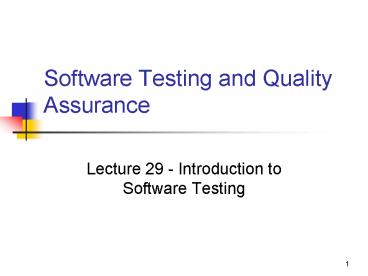Software Testing and Quality Assurance PowerPoint PPT Presentation
1 / 24
Title: Software Testing and Quality Assurance
1
Software Testing and Quality Assurance
- Lecture 29 - Introduction to Software Testing
2
Lecture Outline
- Introduction to testing types.
- Testing activities.
- Introduction to test cases, test oracles and
their execution.
3
Testing Policy
- Only exhaustive testing can show a program is
free from defects. However, exhaustive testing is
impossible - Testing policies define the approach to be used
in selecting system tests For example, - All functions accessed through menus should be
tested - Combinations of functions accessed through the
same menu should be tested - Where user input is required, all functions must
be tested with correct and incorrect input.
4
Software Testing Development Life Cycle
Requirements
System Testing
Integration Testing
Architectural Design
Unit Testing
Detail Design
Implementation
5
Unit Testing
module to be tested
results
software engineer
test cases
6
Unit Testing
module to be tested
interface
local data structures
boundary conditions
independent paths
error handling paths
test cases
7
Unit Testing
driver
interface
local data structures
Module
boundary conditions
independent paths
error handling paths
stub
stub
test cases
RESULTS
8
Integration Testing
- Involves building a system from its components
and testing it for problems that arise from
component interactions. - Top-down integration
- Develop the skeleton of the system and populate
it with components. - Bottom-up integration
- Integrate infrastructure components then add
functional components.
To simplify error localisation, systems should
be incrementally integrated.
9
Integration Testing
- The Big-bang Approach.
- Incremental Approach.
10
Top-Down Integration
A
top module is tested with
stubs
B
F
G
stubs are replaced one at
a time, "depth first"
C
as new modules are integrated,
some subset of tests is re-run
D
E
11
Bottom-Up Integration
A
B
F
G
drivers are replaced one at a
time, "depth first"
C
worker modules are grouped into
builds and integrated
D
E
cluster
12
Thread-Based Integration
A
Top modules are tested with stubs
B
F
G
C
Worker modules are grouped into
builds and integrated
D
E
cluster
13
System Testing
- System Functional Test
- Test entire system against the functional
requirements. - System Performance Test
- Test the non-functional requirements of the
system. For example, - Response times, load testing etc.
- System Acceptance Test
- Set of tests that the software must pass before
it is accepted by the client.
14
Trivial Example
- You have been asked to write a term paper on
Integration Testing in Component Based System.
To do this, you need to find references from a
range of library databases. - You logs on to the KFUPM library system and uses
the search facility to find relevant papers from
IEEE, ACM and Elsevier databases. - One paper of special interest requires
authentication and you have to fill an online
form to receive the paper. - If you are allowed, the paper will be downloaded
and ready for collection. - An email will be send to you once the paper is
ready.
Scenario-based Testing
15
Student Activity
- Identify the possible interactions for the system
testing of library system.
16
Trivial Example - System Testing
- Test the login mechanism using correct and
incorrect login. - Test the search facility using queries against
known source to check that the search mechanism
is actually documents. - Test system presentation facility to check that
information about documents is displayed
properly. - Test the mechanism to request permission for
downloading. - Test the e-mail response indicating that the
download document is available.
17
Regression Testing
- Change do not always effect the entire program.
- Change in one part of system can effect other
part. - After each change
- Entire test suite of a system must be run again.
Need for an automatic test suite execution.
18
Test Activities
- Boils down to selecting and executing test cases.
Test case consists of - Set of test inputs, of if the program is
non-terminating, a sequence of test inputs. - Expected results when the inputs are executed
and - Execution conditions or execution environment in
which the inputs are to be executed.
These steps generally remain same from unit
testing to system testing.
19
Test Case Selection
- Coverage criterion
- Equivalence Partitioning
- Boundary-Value Analysis
- Coverage-Based Testing
- Control-flow
- Data-flow
- Expected behavior of every test input to be
generated. (Test Oracles) - Testing environment.
20
Test Oracles
- Determines whether or not the program has passed
or failed the test case. - A test oracle is
- A program
- A process
- A body of data
- In many cases - directly form the requirements.
- For example, a test case assessing performance -
performance threshold.
Difficult to automate or to assess their quality
21
Test Execution
- Test inputs on the program-under-test
- Record the actual behavior.
Generally can be automated to an extend !!!!
22
Test Evaluation
- Compare the actual behavior with the expected
behavior.
Generally can be automated to an extend !!!!
23
Test Reporting
- Report the outcome of the testing.
- Developers
- Project Mangers etc.
Generally can be automated to an extend !!!!
24
Key Points
- A system typically undergoes a range of testing
types. - Each type of testing is aimed at detecting
different kinds of failures. - Testing boils down to the selection and execution
of test cases.

